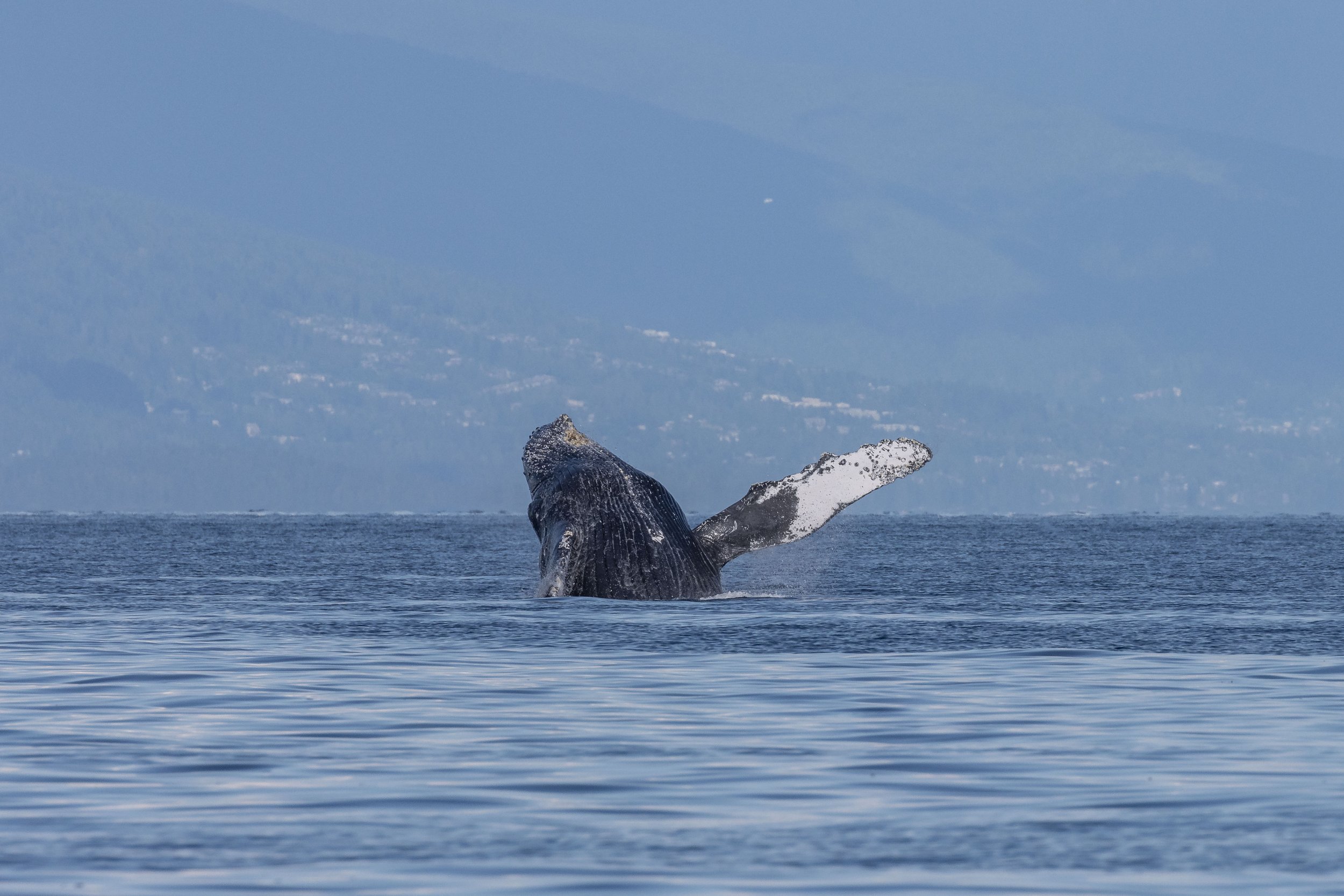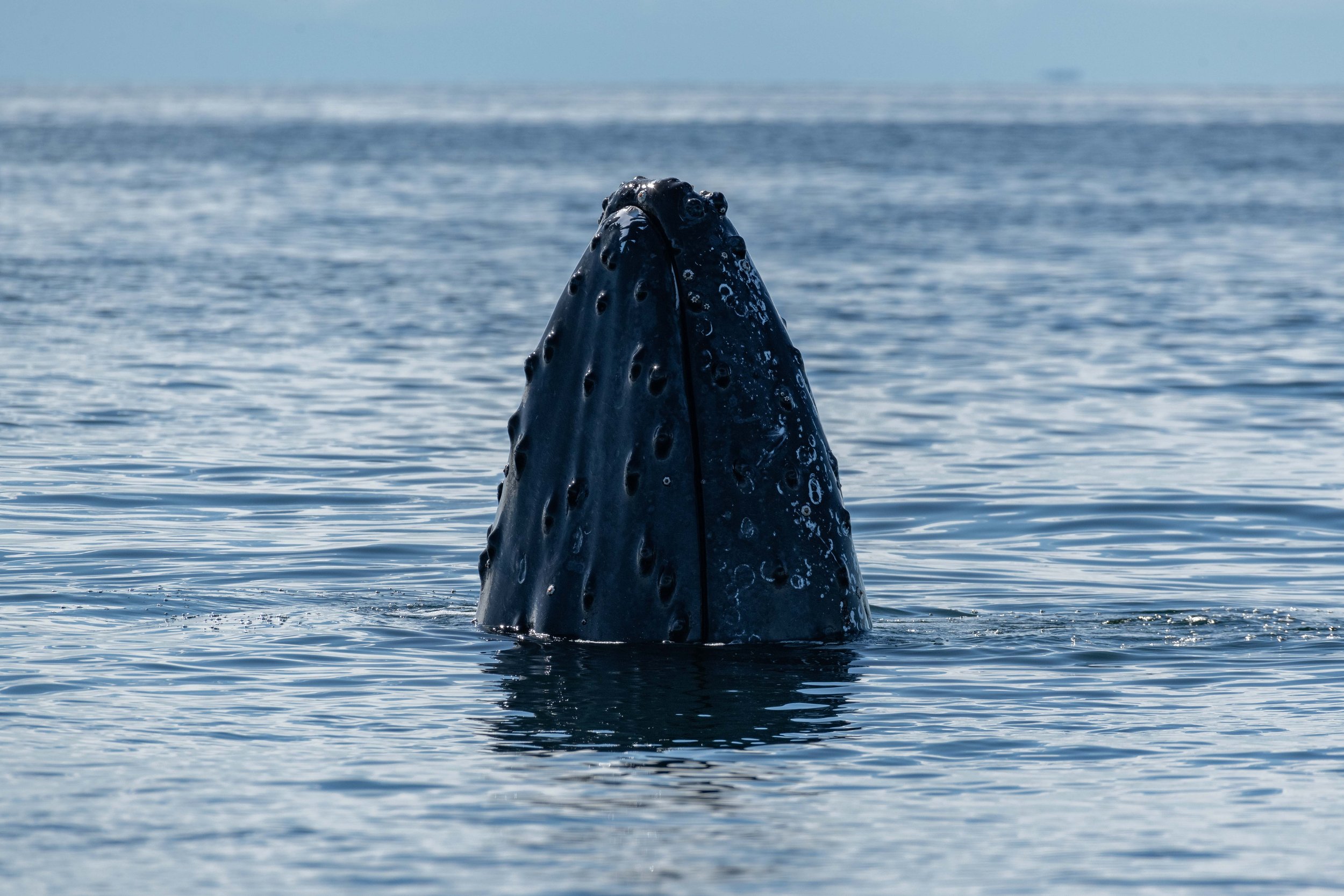June 24, 2024, 3:30 PM - Breachapalooza with 3 youngster Humpbacks!
This trip’s wildlife sightings started nice and early - we were able to spot a River Otter waddling along the docks before we even got down to the boat! This very pregnant female should be giving birth any time now, so we are excited to see baby otters in the area soon!
Once we pushed off the dock we headed on out, eager to continue where we left off from the morning’s trips. Having multiple sightings to reference we had quite a few options for directions to go, but we turned Northeast and headed towards “Humpback land”. While we always keep scanning all around us for whales, typically we are looking for flukes (their tails) or their blows. Today was a bit different though - we got to find them breaching (jumping out of the water), chin slapping (bringing their front half out of the water and slapping it back down), and pec slapping (slapping their side/pectoral fins against the surface of the water)!
When whales are being active like this, it can sometimes be tricky to figure out IDs. However, all three of these individuals cooperated perfectly and gave us nice clear fluke shots to ID from. They were identified as Coyote (BCX0837 calf 2021), Smoke/Squirrel (BCX2183), and Deca (BCY1229).
These three young whales (3 years old, 4 years old, and 4 years old respectively) were very excited today. While they were not interacting super close together for most of the encounter, they were near enough to each other that it was clear that they were communicating back and forth. Coyote was the most active of the bunch, repeatedly chin slapping and breaching away.
At one point Smoke/Squirrel began breaching, and it appeared that they were trying to get Deca to come over. This appeared to work, as Deca came over and joined the party shortly after.
While there’s no solid consensus about why whales breach, there are several theories, including:
Communication - When a large whale jumps out of the water, it’s going to end up making a very loud THUMP at the surface once it comes back down. This impact’s sound can travel very far through the water and could be a very efficient way of communicating with other individuals in the area, whether it is to warn them of potential danger or to invite them over for a snack break!
Pest removal - Humpbacks tend to have a lot of “hitchhikers” on their skin, ranging from barnacles to whale lice. While barnacles have a commensalism relationship with whales (the barnacles benefit, the whales do not benefit nor are harmed), sometimes the load gets a bit much and they need to dislodge some of their unwanted clingers. Quickly forcing their bodies out of the water can help pull old barnacles or pests off, helping the whales stay healthy and happy.
Observation - Whales may breach to get a look at their surroundings above water, to help them better understand where to go and what to avoid.
Attracting potential mates - While the main focus for our humpbacks in our area is to put weight on before heading to the breeding grounds, some individuals may try and woo the ladies ahead of time by breaching to show off their strength and agility.
Fun - It is widely believed that some breaches may simply just be for fun!
After an exciting hour with our whales, we said our goodbyes and left to find other wildlife. We journeyed over to “Stinky Rocks”, a small rocky islet group that is a very popular sea lion haulout spot. Amongst the sea lions was one extra interesting individual - a large male with a brand along his side. These brands help provide scientists with valuable information about where individuals travel and reproduce. This male was branded way back in 2001 in Rogue Reef, Oregon on Pyramid Rock, a critically important Steller sea lion area and home to one of the largest pupping sites for the species in the world!
Once we left our sea lions behind we went for a leisurely cruise back towards our home port. The trip wasn’t quite over though, as we needed to make one last stop at the Gabriola Bluffs to visit our Cormorant Rookery.
In the past years, the biodiversity at the Bluffs has been increasing and we are seeing more and more species returning to this area. The Bald Eagles now have a rival predator species that occasionally resides here - a pair of Peregrine Falcons sometimes nests deep inside the crevices of the rocks. We are excited to see what other new species might call the rocks home in the coming years!
Just before we returned to port, we took a quick peek at our favourite little Eaglet. This little one is now becoming quite large - we wouldn’t be surprised if it fledges in the next few weeks!
As the sun was starting to set we cruised back into the Nanaimo Harbour after an exhilarating day at sea!
Today’s photos were taken by Marine Naturalists Aly Kohlman and Hayleigh Hilbert.
The Pregnant River Otter that we’ve been seeing in the harbour. Photo by Aly Kohlman.
Look how round she is! Photo by Aly Kohlman.
Coyote lifting their fluke for a dive. Photo by Hayleigh Hilbert.
The underside of Coyote’s tail flukes which we use to ID them. Photo by Hayleigh Hilbert.
Coyote breaching. Photo by Aly Kohlman.
Coyote coming in for a landing! Photo by Aly Kohlman.
Coyote lifting both pectoral fins out of the water. Photo by Aly Kohlman.
Coyote Pec Slapping. Photo by Aly Kohlman.
Coyote lifting their head for a chin slap. Photo by Aly Kohlman.
A continuation of Coyote’s chin slap. Photo by Aly Kohlman.
Coyote readying for a chin slap. Photo by Hayleigh Hilbert.
Coyote was full of beans breaching today. Photo by Aly Kohlman.
A beautiful back dive from Coyote. Photo by Aly Kohlman.
Coyote breaching with the Vancouver City Skyline in the background. Photo by Hayleigh Hilbert.
A moon Jellyfish in the water. Photo by Aly Kohlman.
A very interesting angle of Coyote. Photo by Aly Kohlman.
A great look at the tubercles on Coyote’s rostrum. Photo by Aly Kohlman.
A back dive from Coyote. Photo by Hayleigh Hilbert.
Coyote doing a mini spy hop. Photo by Aly Kohlman.
Look at all the barnacles on the bottom of Coyote’s Rostrum! Photo by Aly Kohlman.
The underside of Coyote’s rostrum is covered in barnacles! Photo by Lucy Willis.
Coyote lifting their tail fluke to dive in the sunshine. Photo by Hayleigh Hilbert.
Squirrel’s dorsal fin. Photo by Hayleigh Hilbert.
Deca’s dorsal fin has a very unique shape. Photo by Aly Kohlman.
You can see yellow on Deca’s tail here, which is a temporary coating of diatoms! Photo by Aly Kohlman.
The lovely pigmentation on the bottom of Squirrel’s face. Photo by Aly Kohlman.
Squirrel doing a small breach. Photo by Aly Kohlman.
Squirrel splashing in the water. Photo by Aly Kohlman.
Squirrel letting go a cloud of poop at the surface. Photo by Aly Kohlman.
Squirrel breaching to get Deca’s attention. Photo by Aly Kohlman.
Squirrel lifting their tail with Deca right beside them. Photo by Hayleigh Hilbert.
The unique underside to Squirrel’s tail caused by injury. Photo by Hayleigh Hilbert.
Deca’s back arching with Squirrel lifts their tail beside them. Photo by Lucy Willis.
Deca creating a waterfall from their fluke. Photo by Hayleigh Hilbert.
The underside of Deca’s tail flukes! Photo by Hayleigh Hilbert.
The top of Squirrel’s tail flukes. Photo by Aly Kohlman.
Squirrel’s pectoral fin has two different types of barnacles on it. Photo by Aly Kohlman.
Our open boat watching Squirrel and Deca. Photo by Aly Kohlman.
A cute little Harbour Seal.Photo by Lucy Willis.
A large male Steller Sea Lion on Stinky Rocks. Photo by Aly Kohlman.
A large Steller Sea Lion on the haul-out. Photo by Hayleigh Hilbert.
This Sea Lion was branding in 2001! Photo by Hayleigh Hilbert.
An adult Bald Eagle keeping an eye on things. Photo by Hayleigh Hilbert.
The young bald eagle in the nest. Photo by Hayleigh Hilbert.
A Pelagic Cormorant on the Gabriola Bluffs. Photo by Aly Kohlman.













































